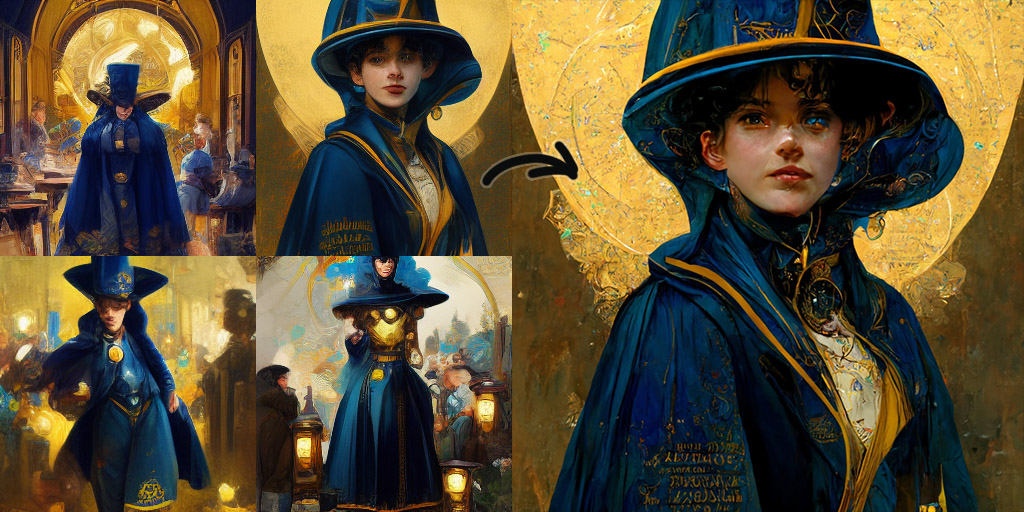Introduction
AI art generators like DALL.E or Midjourney take a text prompt and turn them into images. Midjourney operates through a Discord server where you can see all of the results and the corresponding keywords.
This has sparked fierce debates in the art community and I will explore some of the problems with AI art in this blog post.
6 Problems with AI art
- Can AI create good art?
- Is AI art going to take over social media?
- Is it plagiarism to use artist names in prompts?
- Who owns AI art?
- Can you use AI art in your workflow ethically?
- Is AI art going to replace artists?
Can AI create good art?
When you first encounter AI art it feels like magic. Visually stunning images with just a few keywords!? I was intrigued and signed up to the Midjourney discord to try it out.

You put in a text prompt with /imagine and receive 4 different versions, which you can then upscale to get more details. While this certainly looks cool, you can also tell that it’s slightly off.
Which leads us to the question of whether you can actually make good art with it or if it even is art at all. If you value the human aspect and craftsmanship involved with art, then no, it is certainly not art.
But you can produce striking images! AI seems to be an expert in composition and color theory but struggles with making anything concrete. The image looks amazing at first glance but falls apart if you look at anything closely. Many have even remarked that this makes the images quite uncanny or unnerving to look at.
One thing that you will notice is that there is a distinct lack of even tasteful nudity in any content produced by midjourney. This is was a deliberate choice by developers to moderate the content. It’s one thing when platforms like Instagram do so to make themselves more family friendly but it’s an entirely different beast when the censorship is already happening at the stage of creation.
It’s not like nudity is required for good art, but what’s the point of art if you are not allowed to imagine something?
Is AI art going to take over social media?
This leads us to why AI imagery on social media is also somewhat insidious. It’s already impossible as an artist to keep up with the productivity demands of social media platforms and spend 20+ hours on art that is then looked at for just a few seconds. Someone who utilizes AI is at huge speed advantage when it comes to pleasing the social media algorithms. Many people might not even realize what they are looking at is not real handmade art but (slightly tweaked/overpainted) AI generated images.
You could even imagine a more advanced scenario where the image generation is trained with an additional layer of AI that tries to discern which images look more handmade to get rid of that ‘AI look’. The text prompt is automated as well, with an AI figuring out what kind of combination of keywords gets the most likes on Twitter and Instagram to generate new images.
This vision of million of bots trying to fool you into thinking they are making real art sounds rather dystopian.
Is it plagiarism to use artist names in prompts? Can you sue these companies?
But claiming that AI art is just like photo manipulation/tracing and therefore plagiarist is too simplistic. The datasets are varied enough so that you can’t overlay a single image on top of AI art to show that it was warped into a new shape or traced the outlines.
The are many legal precedents regarding visual plagiarism that go beyond manipulating an existing picture. You can read some of them here:
Visual plagiarism: when does inspiration become imitation ?
Basically, tracing and photo manipulation is almost always classified as copyright infringement. But it is very difficult to win a legal case when someone has copied a ‘vibe’ or ‘style’.
Are there other ways artists can object to their images being used in datasets?
I can actually offer a unique perspective on this because I worked in data privacy for a bit! Organizations like Apple or Google are obliged to comply with privacy regulations such as the European General Data Protection Regulation (GDPR) using concepts like differential privacy.
Whenever sensitive data about individuals is released i.e. hospital records, crime data etc., the data must be distorted in such a way that you cannot identify an individual in the dataset. Differential privacy means that a dataset will not be substantially different when an individual is in- or excluded from it.
This concept as of right now applies to personal information but it could be expanded to include copyrighted material.
If we apply this concept to AI art it would mean that these companies would have to prove that the image generation works about the same whether an artist’s name is included in the text prompt or not.
I think this would be a nice middle-ground between banning the use of artwork in data sets as a whole and letting it run wild.
Who owns AI art?
The first question is perhaps also the hardest. When you first encounter
Can you use AI art in your workflow ethically?
The first question is perhaps also the hardest. When you first encounter
Is AI art going to replace artists?
The first question is perhaps also the hardest. When you first encounter